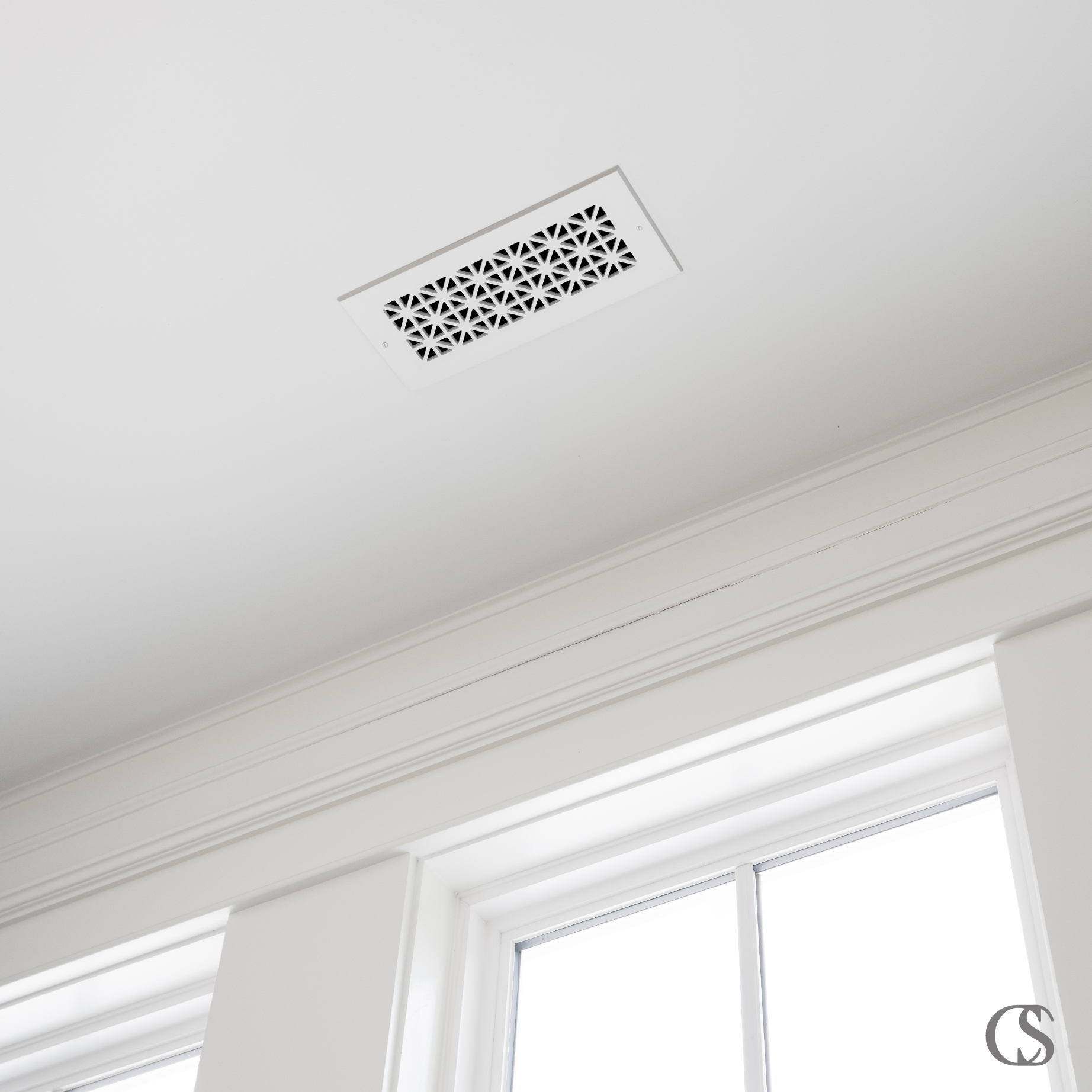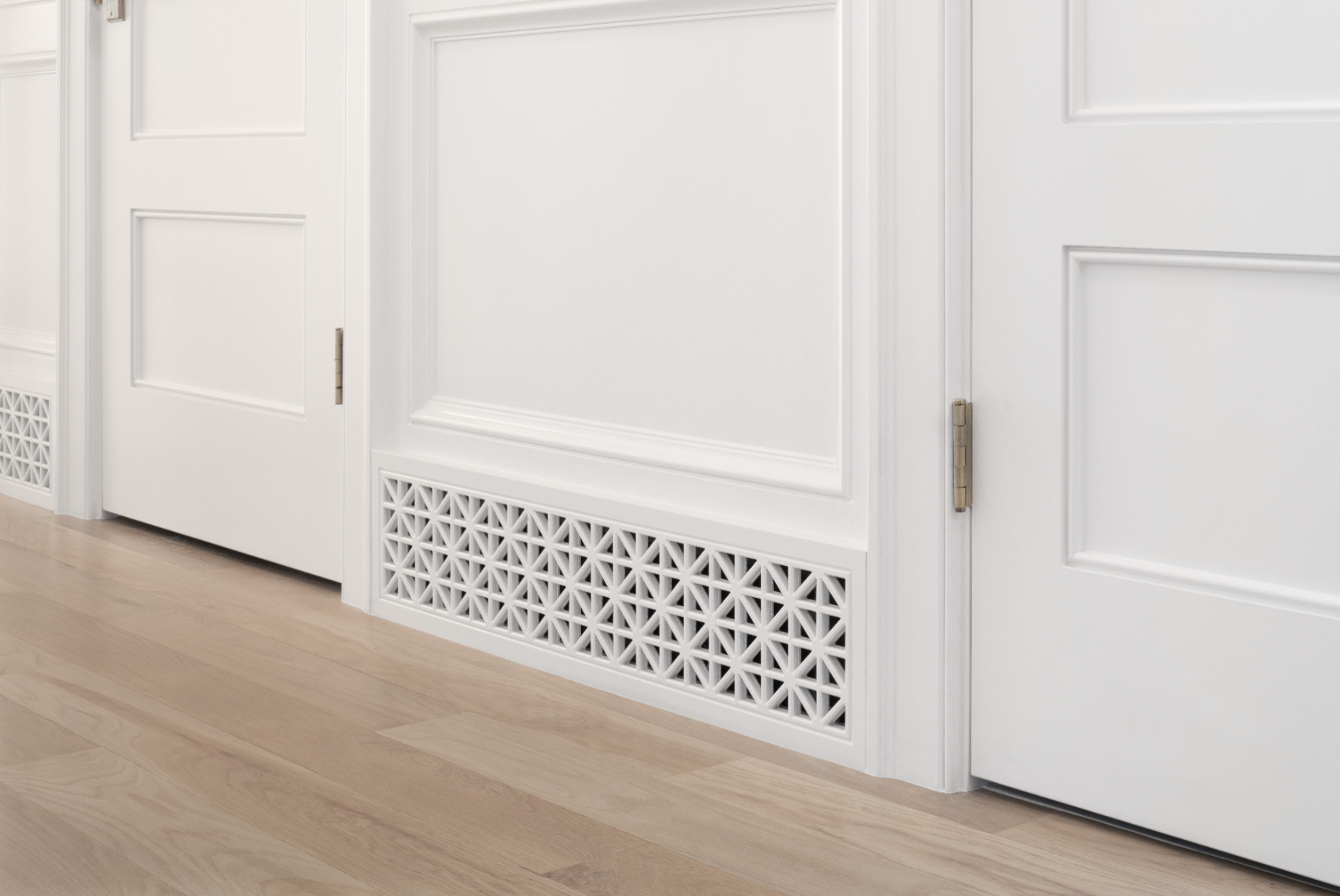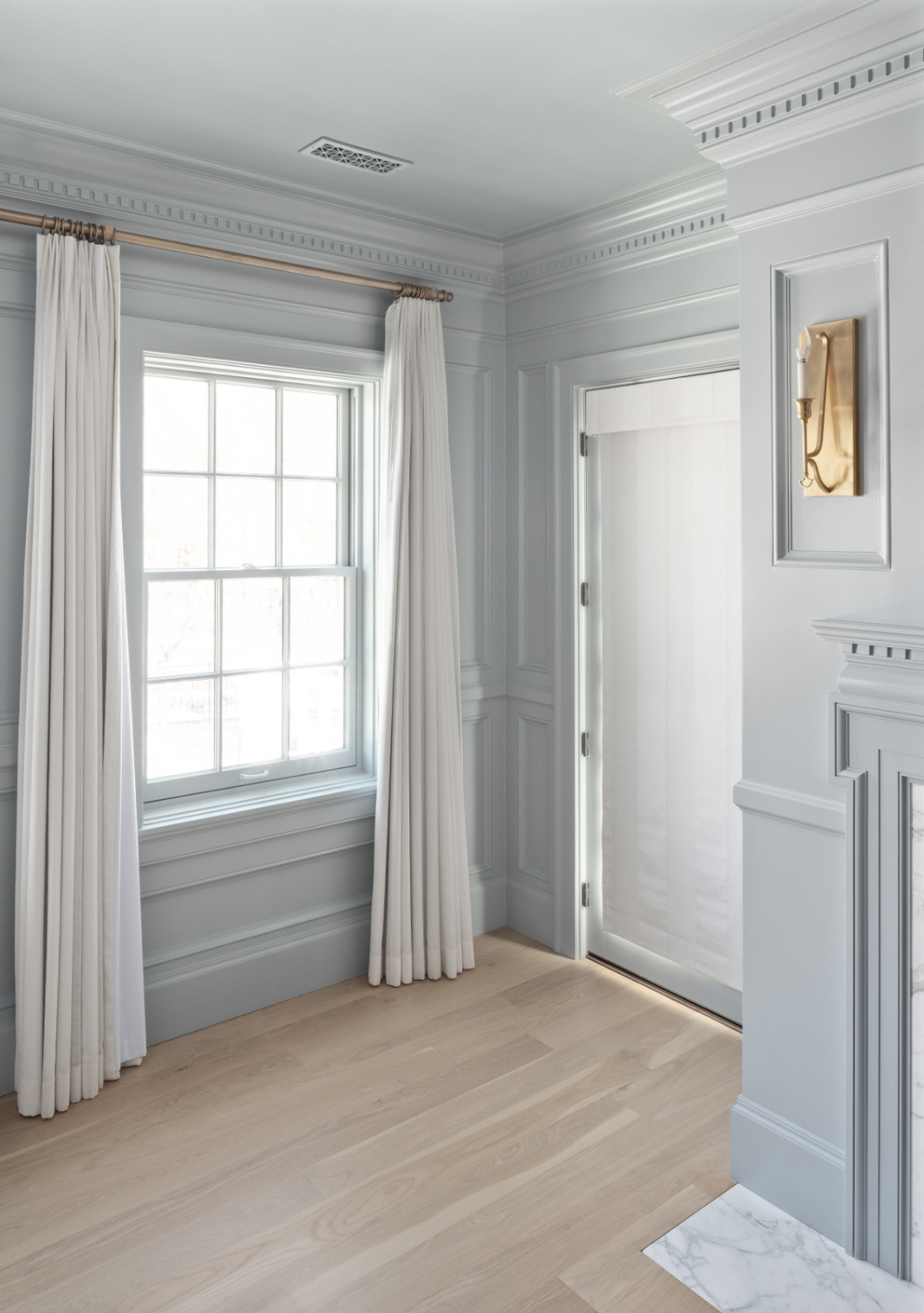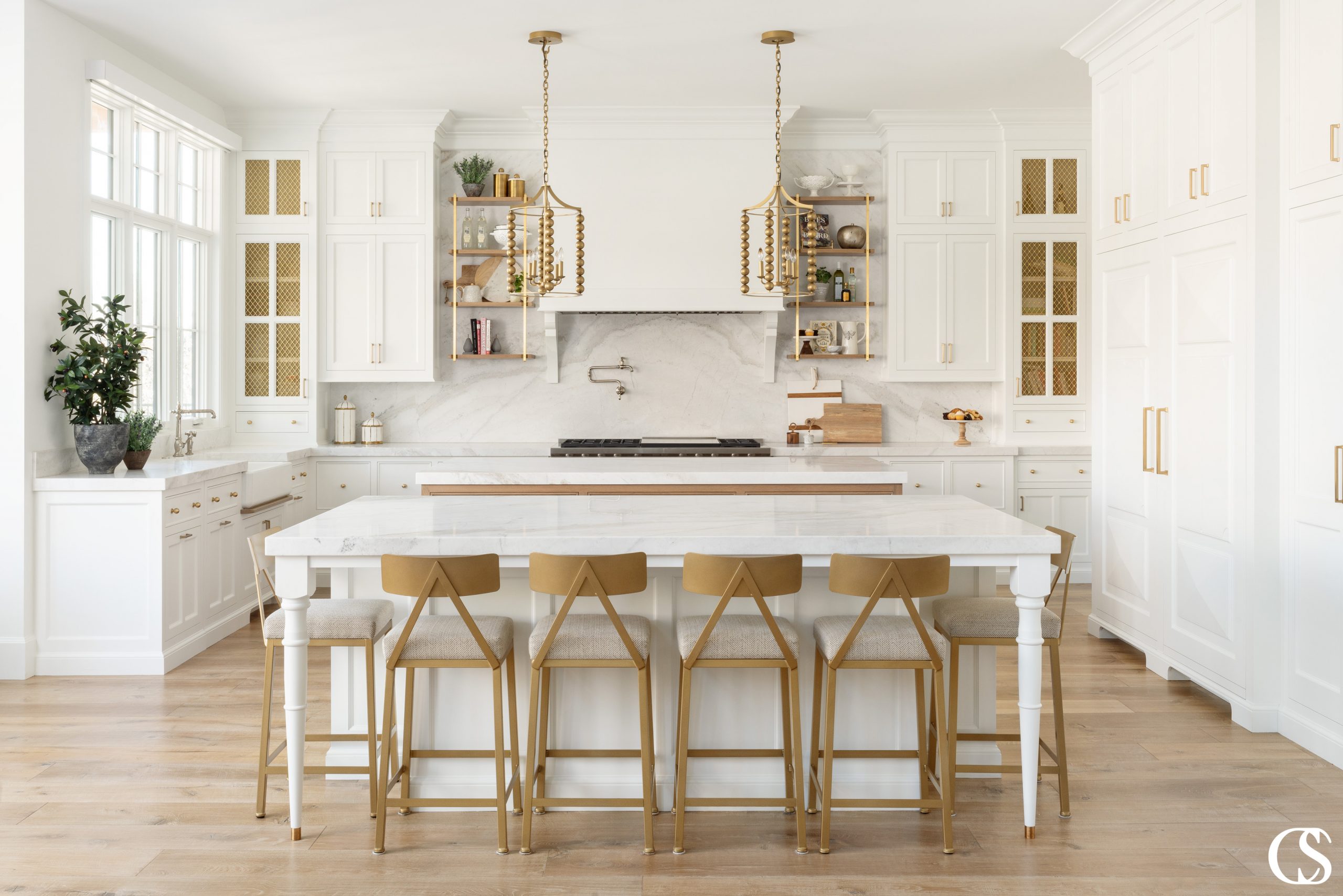Still haven’t decided which vent cover material is best for you? We’re here breaking down all the pros and cons of plastic, metal, or wood vent covers so you can be sure which one will add to the durability and design of your home, without breaking the bank.
Spoiler alert: custom wood vent covers tick all the boxes in all the best ways. But more on that to come!

Designer: Christopher Scott Cabinetry & Design
Vent Cover Basics
First, before we get into why wood is a great choice for your own vent covers, let’s—ahem—cover…some vent basics and commonly asked vent-related questions.
What is the difference between a vent and a register?
First, the vent is the actual hole in your wall, ceiling, or floor that needs a cover.
A standard vent cover will fit within the dimensions of the vent hole and prevent most things from entering the vent, protecting the HVAC system while still allowing air to flow into the room for heating and/or cooling purposes. This type of vent cover is also often referred to as a vent grille.
A register is similar to a vent cover, but it has the added functionality of being able to direct air or even close it off from a room by moving a damper attached to the register.
What is the difference between an air supply and air return?
The difference between an air supply and air return is right there in the naming of the terms: an air supply vent supplies air to a room, whereas an air return vent circulates air back into the HVAC system. Most rooms in any modern home will have at least one air supply vent, but it is only necessary to have a few larger and well-placed returns throughout the home.
What are the different types of vents?
The different types of vents are actually the ones discussed in the previous question—a vent is either there to supply air or return it to the system. So the two types of vents are return and supply vents. Depending on the type of system and size of home you have, both types of vents can be found on the floors, walls, or ceilings of a home.
Are vent covers necessary?
Do vent covers make a difference, or are they purely decorative? As alluded to above, vent covers are absolutely necessary for any home. For one, they work to protect your HVAC system from large debris. Two, they increase your heating and cooling system’s efficiency and can lower your monthly bill when used wisely. That means closing or covering vents in rooms that aren’t often used, directing the air to other spaces in your home which will mean that, three, your vent covers help to maximize your family’s comfort. And number four? The right, often custom, vent covers can increase your home’s value, both monetarily and aesthetically. But we’ll get more into that soon.
LEARN MORE: Common Air Return Vent Questions

Designer: Christopher Scott Cabinetry & Design
Wood Vs Plastic Vs Metal Vent Covers
When it’s time to choose the best vent covers for your home, there are three main competitors: wood vs plastic vs metal vent covers. Metal vent covers are the most commonly seen type of vent cover out there. They fall into the “builder basic” category and are often standard issue in new construction homes. Standard metal grilles are the unattractive “necessities” that people have widely accepted as the ugly spot in otherwise beautifully designed homes.
Plastic vent covers are often seen on things like bathroom vent fans but can also be used as standard vent covers. While this is less common, some people like the cheap, lightweight option. These days, both decorative wood and metal vent covers are now available, effectively snuffing out the need for the standard issue eyesores.
What type of metals are used for vent covers?
The most common types of metal used for vent covers are cast iron, cast aluminum, brass, and steel. The latter three are best for high humidity areas such as bathrooms due to their rust-resistant qualities.
There are also two different types of manufacturing most metal vent covers. One is to use sheet metal which is thin, light, and easy to laser cut designs into. The other option is cast metal that is thick and expensive but will give you the dimensional depth you can’t get from sheet metal.
BUY: Get Your Custom Decorative Vent Covers Now!
What types of wood are used for vent covers?
There are many types of wood used for vent covers, but most often you’ll find wood covers made of hardwoods, like oak, maple, and cherry. Sometimes you’ll get a decorative wood vent cover that has a hardwood “body” with a thin veneer “face” so you can match to your existing materials if you plan to stain.

Designer: Christopher Scott Cabinetry & Design
Another wood option used for decorative vent covers is HDM—or high-density machine board—and is sold ready for primer and paint. This is a high-quality pressed wood that makes it easy to get a beautifully intricate design while providing just the right customizable and dimensional detailing your home needs. This material, however, is not appropriate for floor vent covers.
Which metal and wood types are best for vent covers?
Regardless of whether you choose metal or wood for your custom vent covers, you need something that not only does the job of allowing free-flow of air throughout your home but that won’t weaken or crumble over time. This means that material, placement, and care all come into play when choosing between metal and wood vent covers.
We are partial to wood when it comes to any vent on the walls or ceilings, or even toe kick vents, because of the built-in, customized, true-to-home feel they give. Being able to paint to your exact color palette or even match the design theme of existing furniture or architectural pieces in the home makes custom wood vent covers a perfect choice.
Cast metals for floor vents are optimal due to their strength and durability. The only catch is that they are typically more expensive and more limited in options.
What are the pros of using metal for vent covers?
Pros of using metal vent covers include:
- Strength for walking on or moving furniture across if used on floor vents
- Less concern about water damage in wetter areas like the bathroom
What are the cons of using metal for vent covers?
Cons of using metal covers include:
- Cast metal vent covers can be very costly
- Doesn’t offer the same level of true-to-home character as wood can
What are the pros of using wood vent covers?
Pros of using wood vent covers include:
- Can be very cost-effective if choosing the right material, like HDM
- Adds depth, texture, and a truly built-in feeling to your customized home
- Can be painted to exactly match your existing interior design, or repainted if that were to change
- Has a timeless, yet modern feel
- Perfectly durable for all wall and ceiling vents
What are the cons of using wood vent covers?
Cons of using wood vent covers include:
- They’re not a great idea for floor vents
- You’ll need to ensure proper ventilation in places like the bathroom, just like you would for wood molding, etc.
Overall, we believe custom wood vent covers are an incredible investment that will enhance the dimensional beauty, decorative cohesion, and personalized feel of your home. It’s the attention to these kinds of details that will truly set your home apart and make you feel 100% at HOME.
Vent Cover Maintenance And Care
To keep your vent covers looking and functioning their best, it’s important to clean them regularly. Going over your vents with the soft brush attachment of your vacuum is great for the standard cleaning. However, twice a year, you’ll want to give them a more thorough cleaning.
Here’s how to deep clean your vent covers:
- Carefully remove the vent covers by unscrewing them from the wall or floor. Set the screws aside in a safe space
- If your vent covers are made of plastic or metal, you can soak them in a solution of warm, soapy water, then use a cloth or scrub brush to remove excess debris.
- Rinse and dry the vents thoroughly before re-installing them.
- If your vent covers are painted wood, you can use a mixture of 1 cup vinegar, 2 cups warm water, and 1 Tablespoon baking soda. Dip a soft cloth into the mixture and gently wipe the wooden floor vent covers clean. Then wipe with a clean cloth dipped in water, dry completely, and re-install the covers.
Custom Design Options For Vent Covers
In my opinion, the best vent covers for home design are wooden vent covers. There are endless design possibilities available with wooden vent covers. The real reason I love them is because it is an easy way to upgrade the look of your home. In a time when people want to add unique touches to their homes, these are right on trend. Custom wood vent covers don’t cost a lot more than their metal or plastic counterparts, but the design difference is exponentially greater. Instead of sticking with the standard grille pattern, you can select a look that suits your style and elevates your home design.
Custom Decorative Air Vent Covers For An Instant Luxury Upgrade To Your Home
Christopher Scott Design has created the most beautiful and functional solution to run-of-the-mill vent grates so you aren’t forced to sacrifice your home’s unique style. Our decorative air vent covers add perfect dimensional detail to anywhere from a kitchen cabinet toe kick to a bedroom wall, from a central return vent to a bathroom ceiling vent. Wherever they are, they’re guaranteed to add valuable form and function to your home. Installed with other modern air vent covers from us, a cohesive and high-end built-in look can be achieved throughout your home for ultimate architectural and design harmony.
Some of the benefits of our decorative vent covers include:
- Premium Home Upgrade: Christopher Scott Cabinetry’s Custom Decorative Air Vent Covers are designed to help you bring your distinctive sense of style into every room in the house. Our beautiful and functional designs will magnify what is already unique about yourself or remind everyone else just how stylish they really want their home living environment to be!
- Meticulous Design: Vent covers are a great way to add design impact and improve the look of your home. With our custom vent cover designs, you can choose from different shapes for each room in order to get that perfect personalized feel!
- High-Quality Fabrication: The best way to ensure that your vent cover looks like it was always meant for the home is by using high-quality materials. We use premium machine board. Our vents are made from high-density machine board (HDM) which can be primed or painted any color of choice! All elements created through Christopher Scott Design will have intricate details and beauty without breaking budget constraints.
- Versatile Performance: With its sleek design, our decorative vent covers offer a high-quality, primer-and-paint-ready product. Easy installation. Functional and aesthetic. These can be used as decorative ceiling vent covers, wall vent covers, toe kick air duct vent covers, return air vent covers, air supply vent covers, bathroom air vent covers, and more.
>> Get Your Custom Decorative Vent Covers Here <<
At Christopher Scott Design, we only use high-quality materials we trust. That’s why our vent covers are made of premium, high-density machine board (HDM), ready to prime and paint to your exact specifications, and made to withstand temperature changes common to any HVAC system. Working with HDM also makes it possible to create the intricate and flawless decor grates you should expect from Christopher Scott Design, at a fraction of the cost of cast metal.
Contact us to find out more about how we can help with your latest project or visit our Amazon store to upgrade your air vents today.



